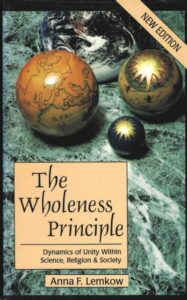The Wholeness Principle – Dynamics of Unity within Science, Religion and Society
By Anna Lemkow.
322 Pages | Published in 1990, second Quest edition 1995 | Softcover | Quest Books, U.S.A. | ISBN: 0835607151.
Dutch translation: Het Heelheid Principe - De Dynamiek van Heelheid in Wetenschap, Religie en Samenleving | Published in 1993 | Softcover, incl. index, word list & literature list | Uitgeverij der Theosofische Vereniging in Nederland, Amsterdam | ISBN: 9061750660.
It becomes more and more clear, the present-day tendency of separation amongst civilizations and religions is forming a threat for the global survival of humanity. A philosophy, in which an emphasis is put on that 'unity' present behind separation is called 'holism'. Holistic literature is characterized by the postulization of possible connections between religion (mysticism) and science (physics), yet inclusion of its societal dimension often seems to be forgotten. It is The Wholeness Principle, which discusses this societal dimension to an elaborative extent.
Annas Lemkow researches an enormous scala of subjects. First, she discusses the rise of modern science and its effects on our worldview. Then, she involves the spiritual dimension by mapping out similarities and differences existing amongst the major religions of our world, the relationship between religion and science and the place mysticism has in view of the whole of human knowledge. Finally, she carefully looks at societal developments that have taken flight as a result of the rapid implementation of technology, such as industrialism and automation. She sketches the peripheries of a political vision adjusted to the new world order: one in which humankind does finally acknowledge East and West, North and South cannot live without each other.
From Chapter 12 - 'The Essential Unity of all Religions':
" Whether we listen with aloof amusement to the dreamlike mumbo jumbo of some red-eyed witch doctor of the Congo, or read with cultivated rapture thin translations from the sonnets of the mystic Lao-tse, or now and again crack the hard nutshell of an argument of Aquinas, or catch suddenly the shining meaning of a bizarre Eskimo fairy tale, it will be always the one, shapeshifting yet marvelously constant story that we find, together with a challenging persistent suggestion of more remaining to be experienced than will ever be known or told. "
- Joseph Campbell (1904 - 1987), The Hero with a Thousand Faces (p. 3).
 Bezig met bijwerken...
Bezig met bijwerken...